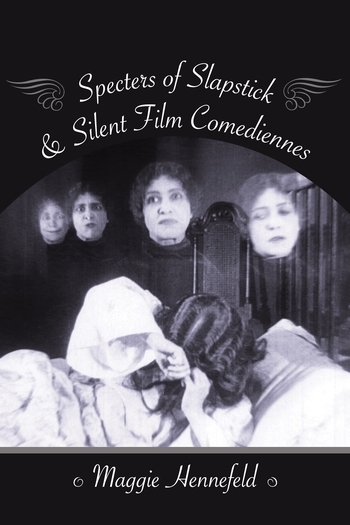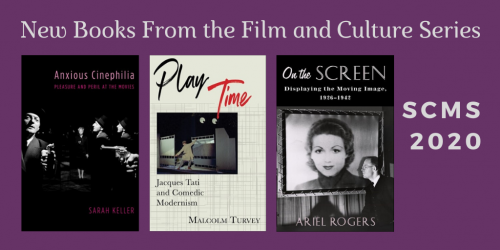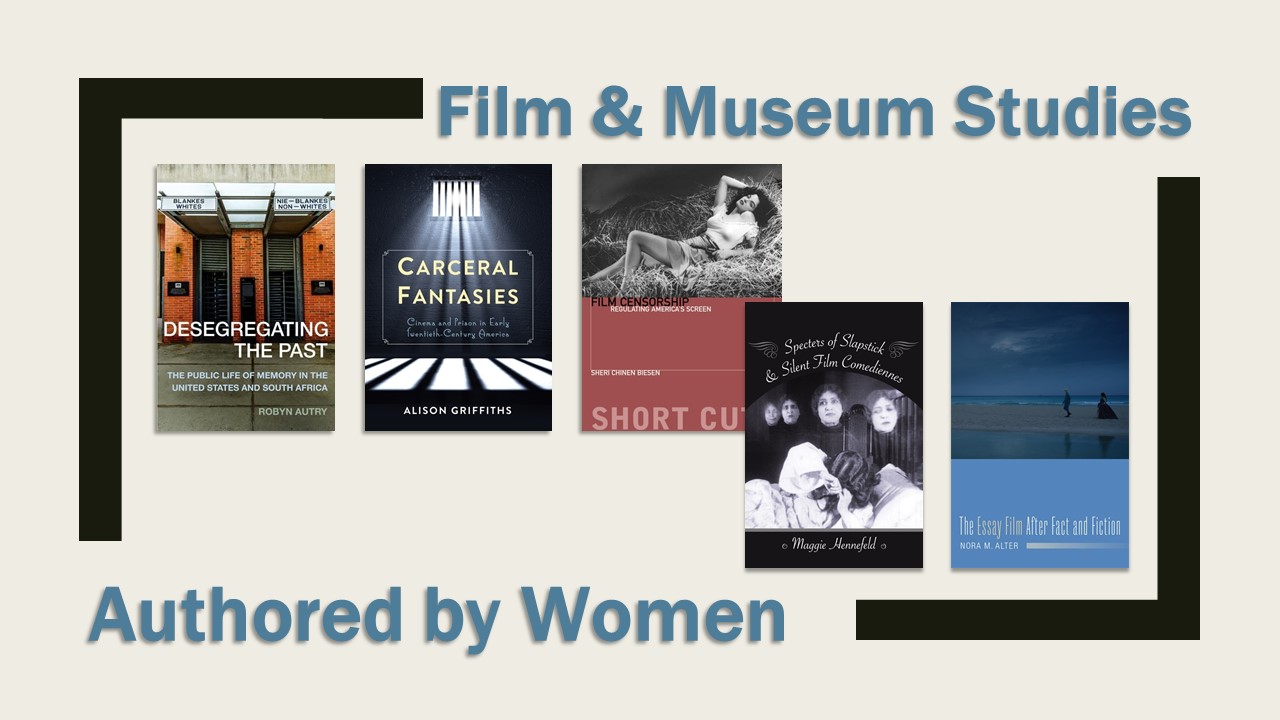Comedies of Catastrophe, Contagion, and Self-Quarantine: A Spectral Playlist for the Impromptu Apocalypse

One of my favorite books to have worked on from the past few years is Maggie Hennefeld’s Specters of Slapstick and Silent Film Comediennes. In this post she offers a list of comedies featuring women who focus on societal catastrophe, epidemic contagion, and hysterical self-quarantine. These are not normally topics we think of when we think of comedy, but as Maggie shows laughter, and dark comedy offer new ways of thinking about these subjects.
• • • • • •
Recent weeks have completely upended my perception of time—hours feel more eventful than eons, the compulsive renewal of hope is episodically shattered, and the future now appears even less imaginable than the end of capitalism. At the same time, I’ve been inspired by all of the heartfelt social media posts, generous pooling of crucial resources, incisive and provocative playlists, and virtual forums that are quickly gathering steam as we scramble to adapt our long-held intellectual commitments to the escalating present of political crisis, economic freefall, and public-health pandemic. To that end—and in the spirit of snatching a vestige of continuity without disavowing the unraveling horrors—I’ve mined the archive for its most evocative specters.
This playlist features many old ghosts that have always haunted me as well as some new hobgoblins that I’m afraid I still misrecognize. Its topicality is apparent: I focus on comedies about societal catastrophe, epidemic contagion, and hysterical self-quarantine. I was struck by how many of the films I hold most dear fall under the umbrella of one or more of these three categories. This should not have come as a surprise. As a feminist film historian, I believe deeply in the power of the archive to reveal itself in the moment of its necessity. Old ghosts inhabit those roads not taken (not just regret, but unrealized potential) and offer us lifelines toward a less catastrophic vision of what might still come to pass (if we only knew where to look for it!).
I hope it does not seem cavalier to thematize such raw, anxious, and gravely serious subjects—catastrophe, contagion, and quarantine—in the context of the present. Comedy has always been a vividly messy business. Slapstick has a mortgage on assault and violation, and laughter is condemned to walk the line between righteous truth telling, therapeutic avoidance, and reactivated trauma—often doing so more spastically than gracefully. Contagion is an occupational hazard of involuntary laughter, which feels the most satisfying when shared or collective. If forced to laugh in isolation, that good feeling of joyful euphoria might suddenly buckle—giving way to hysteria, pathos, morbid anxiety, and existential desperation.
But laughter has always been a risk. Uproarious comedy gains utopian momentum from the grotesque shattering of all continuity with past traditions, which it stockpiles into a wasteland of yesterday’s exhausted decisions. Perverse as it may sound, laughter opens a gap toward something else. My wager (from the bunkers of self-quarantine) is that this something else will unfold in the abandonment of promiscuous rewatching. With an eye toward the archive, we might even begin to espy a strange shadow of lost hope not too far ahead on the horizon …
PART I: JOYFUL CATASTROPHE
Mary Jane’s Mishap (G.A. Smith, Britain, 1902), featuring Laura Bayley as Mary Jane.
A rebellious housewife breaks her self-quarantine by catastrophically erupting out of the chimney. She returns as a dancing specter to haunt her own tombstone, which reads: “Here lies Mary Jane. Rest in Pieces.”
Daisies (Vera Chytilová, Czech, 1966), featuring Jitka Cerhová and Ivana Karbanová.
Two women both named Marie go on a carnivalesque rampage in this anarchic/absurdist Czech New Wave film. They’re vampires not for bloodsucking capital but for overly sweet desserts, especially sheet cake! They alternately engorge and destroy mouthfuls of food between gasps of gluttonous laughter in an iconic food-fight scene.
I’m Your Half (Julia Boutteville, Antoine Gazaniol, and Mathias Louis, France, 2019), featuring Julia Boutteville and Marc Riso.
A satirical screed against “manspreading”: hell hath no fury like a bored, alienated, unappreciated housewife. (Because isn’t housewifery basically an unwaged career of self-quarantine?) The spouse in this short film demonically exacts her revenge against a lifetime of domestic servitude while laying waste to at least three weeks’ worth of grocery store rations. Watch this video clip on Vimeo.
PART II: CONTAGIOUS LAUGHTER
Laughing Gas (Edwin S. Porter, US, 1907), featuring Bertha Regustus.
A Black woman is given nitrous oxide (a.k.a. “laughing gas”) at the dentist while having her tooth extracted. She spreads her laughter contagiously to everyone around her, including streetcar riders, service workers, police officers, and church congregants (among whom there’s no room for the holy ghost, let alone six feet of physical space).
A Question of Silence (Marleen Gorris, Netherlands, 1982), featuring Edda Barends, Nelly Frijda, Henriette Tol.
Three women who don’t know one another burst into uncontrollable laughter while murdering a misogynist boutique owner. Their contagious euphoria returns at the courtroom scene of their murder trial, where their collective outbursts humiliate all pretenses of pomp and circumstance.
Lachen in der U-Bahn (Matt Grau, Germany, 2011), featuring participants in a work of spontaneous performance art that leaves no room for social distancing.
A woman’s uncontained amusement while watching a funny thing on her phone quickly spreads like wildfire to other (mostly female) bodies around her on the Berlin subway.
PART III: HYSTERICAL SELF-QUARANTINE
Lea and the Ball of Wool (Cines, Italy, 1913), featuring Lea Giunchi.
A teenage girl doesn’t mind self-quarantine but would rather spend that time reading her books than tend to her knitting as her parents have commanded. Rigid prohibitions cannot withstand the lure of disastrously lost objects. Lea utterly abases her parents’ home in comical pursuit of a lost object she’s determined to destroy once and for all. Check out the DVD.
Daisy Doodad’s Dial (Florence Turner and Larry Trimble, UK, 1914), featuring Florence Turner (a.k.a. the “Vitagraph Girl”).
A bored housewife trains day and night to compete in an amateur face-making competition. When her hysterical gestures threaten to upset the gendered segregation of public vs. private spaces, Daisy shuts herself up in her bedroom, where she’s haunted by decapitated superimpositions of her own comic/horrific face-making.
Whatever Happened to Baby Jane? (Robert Aldrich, US, 1962), featuring Bette Davis and Joan Crawford.
A scene that probably needs no introduction: A psychotic former childhood starlet, Baby Jane, torments her paraplegic sister, Blanche, by locking her in her room, feeding her dead rats, and cackling sadistically at her rising existential terror. The laughs and shrieks are delicious! But the film has much to say about ambivalent memories, which we’re left to stew in during long bouts of self-quarantine.
Read more by Maggie Hennefeld. Enter our SCMS 2020 drawing for a chance to win a free book. Although we encourage you to buy from your local bookstores, we are offering a 30 percent conference discount when you order from our website. Use coupon code SCMS20 at checkout to save on our SCMS books on display.







